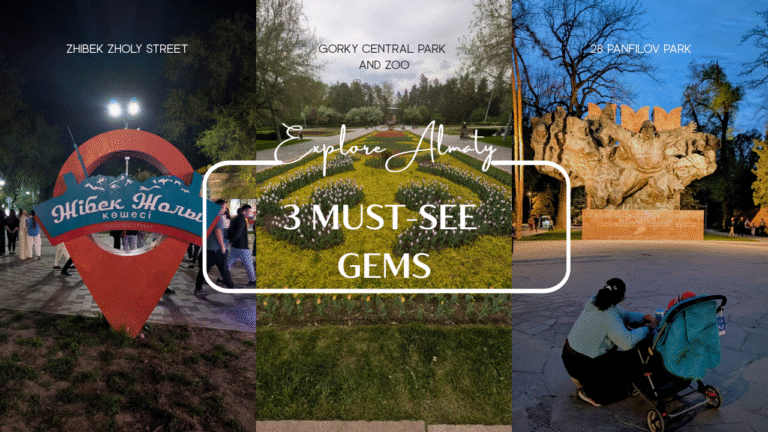Bratislava, Slovakia’s charming capital, may be small, but it packs a punch with its mix of medieval history, quirky statues, and hearty cuisine. With a compact Old Town and a castle that looms over the city like a fairy-tale fortress, it’s the perfect place to explore on foot. Here’s how to make the most of a day in this delightful city!
1. Start at the Top: Bratislava Castle
No visit to Bratislava is complete without a stroll through Bratislava Castle, perched atop a hill offering panoramic views of the city and the Danube River. The castle’s history stretches back to the 9th century, though today’s structure is largely a Baroque reconstruction. Legend has it that its four corner towers resemble an upside-down table, earning it the nickname “The Inverted Table Castle”!

Wander through the castle and explore some notable spots:
Baroque Gardens – A beautifully restored part of Bratislava Castle, the Baroque Gardens are a tranquil escape with symmetrical flower beds, trimmed hedges, and elegant pathways. Originally designed in the 18th century under Maria Theresa’s reign, they provide a regal backdrop with sweeping views of the Danube.

Vienna Gate – The Vienna Gate (Viedenská brána) is one of the grand entrances to the castle, offering a direct line of sight towards Vienna on a clear day. This historic gateway was once the main access point for nobles and travelers arriving from the Austrian capital.

Bosorka (The Witch Statue) – Tucked away in the castle grounds, Bosorka, or the Witch Statue, is a quirky nod to Slovakia’s folklore. It depicts a woman with wild hair and a broom, a reminder of medieval times when tales of witches and superstition were deeply woven into local culture.

Svätopluk Statue – The equestrian statue of Svätopluk honors the legendary ruler of Great Moravia, who fiercely defended the region from invaders. His sword, positioned upright, symbolizes strength and national pride, though the statue has sparked debate due to its somewhat modern and dramatic design.
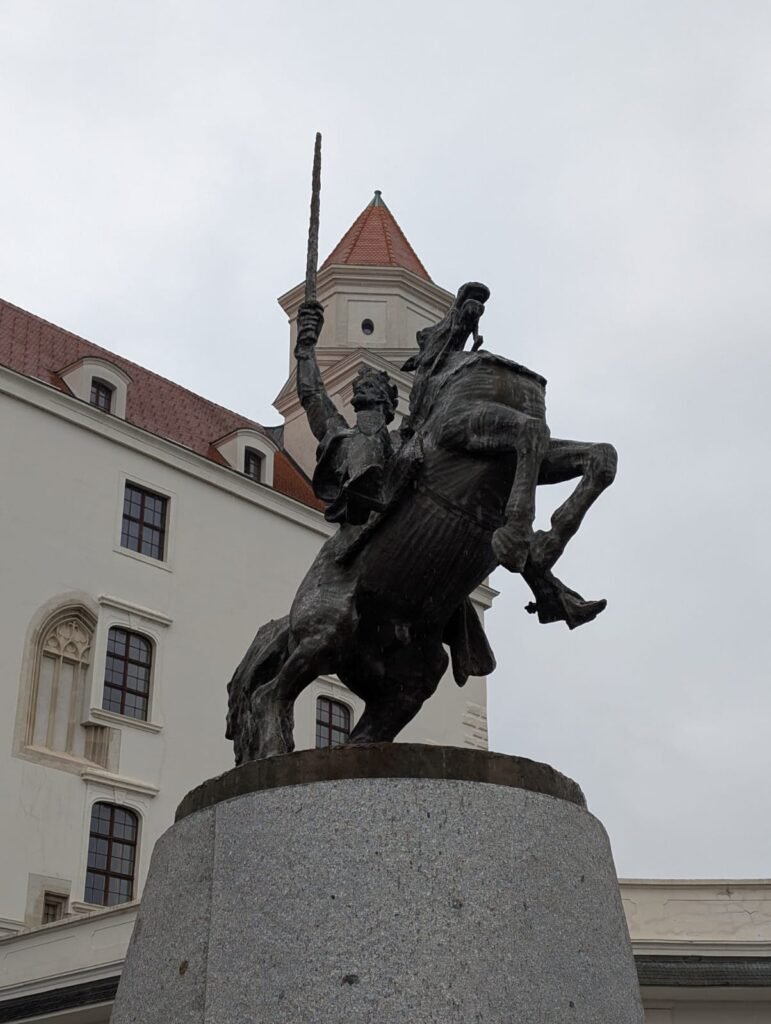
Statue of St. Elisabeth of Hungary – This elegant statue pays tribute to St. Elisabeth of Hungary, a 13th-century princess known for her charity and care for the poor. A symbol of kindness and compassion, her legacy continues through hospitals and charitable organizations named after her across Europe.

💡 Tip: The castle museum is skippable unless you’re a die-hard history buff—save your €10 and explore the free castle grounds instead!
2. Descend into the Old Town’s Fairytale Streets
From the castle, follow the cobbled paths down into Old Town, where every turn seems to reveal another hidden gem.
First up is St. Martin’s Cathedral, the grand Gothic church where Hungarian kings were once crowned. The grand structure is Bratislava’s most important church, famous for being the coronation site of 19 Hungarian kings and queens. Its spire, topped with a replica of the Hungarian Crown, stands as a reminder of the city’s royal past, while hidden catacombs beneath the church add an eerie touch to its history.
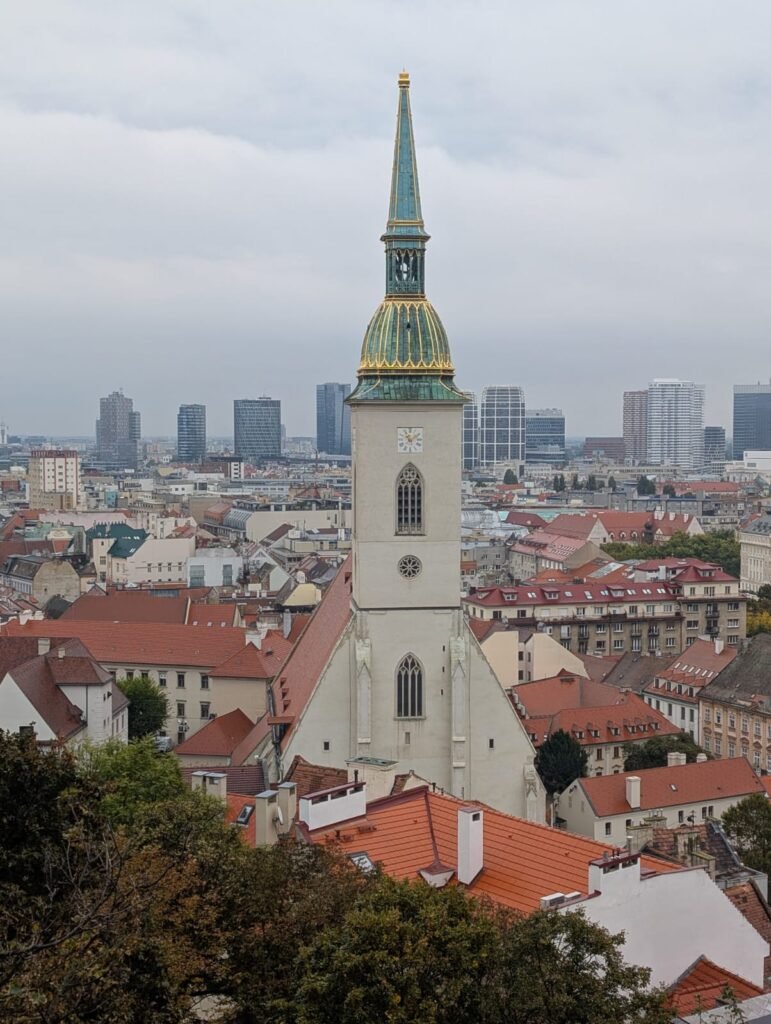
Nearby, the House of the Good Shepherd is one of the narrowest buildings in Europe and a great photo stop. It is a charming 18th-century Rococo-style house that now hosts a clock museum. Once a merchant’s home, its yellow façade and delicate ornamentation make it a picture-perfect stop on the way down from Bratislava Castle.
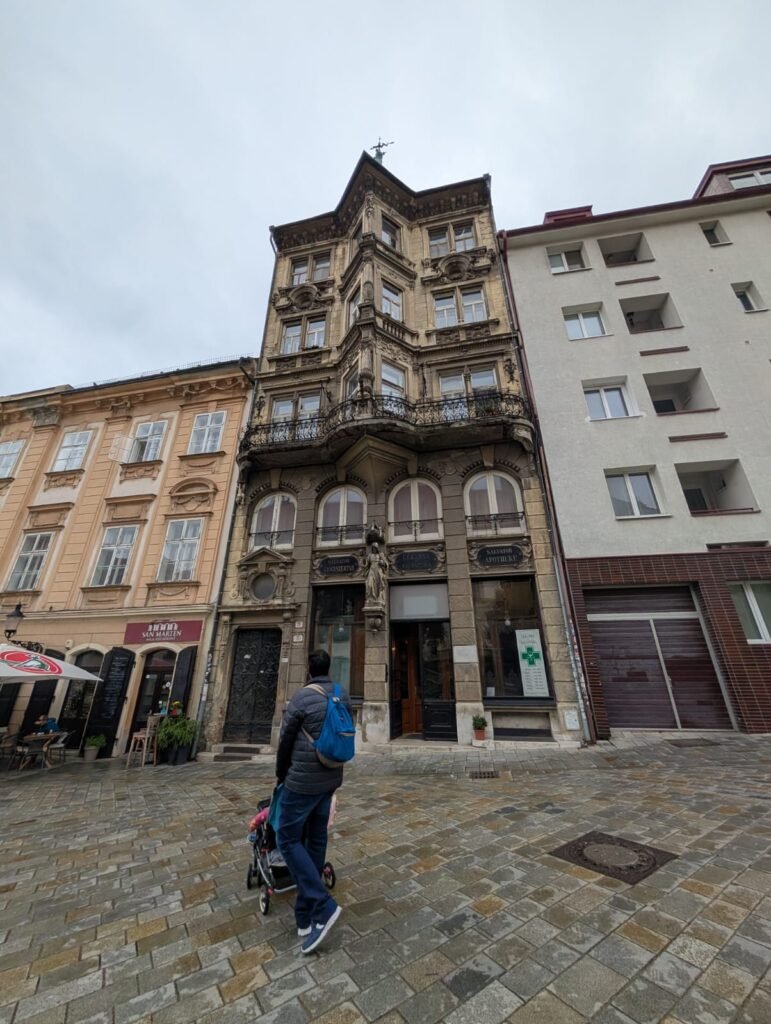
Once inside Hviezdoslav Square, soak in the lively atmosphere, surrounded by fountains, sculptures, and tree-lined walkways. Named after Slovakia’s famous poet Pavol Országh Hviezdoslav, this lively square is lined with cafes, fountains, and statues, making it the heart of Old Town. It’s the perfect place to soak in the city’s atmosphere. Be sure to say hello to Hans Christian Andersen’s Statue, a nod to the famous writer’s visit to Bratislava. And for a little fun, find the giant chessboard on the ground—challenge a travel buddy to a quick game!

3. Meet Bratislava’s Most Famous Residents—The Statues!
Bratislava’s statues are some of the quirkiest in Europe, each with its own story. Look out for:
Čumil (Man at Work) – A bronze worker peeking out of a manhole, smiling at passersby. Perhaps Bratislava’s most famous statue, Čumil is a bronze figure of a sewer worker peeking out of a manhole with a mischievous grin. Installed in 1997 as part of an effort to brighten up the Old Town, locals joke that he’s either just taking a break from work or sneakily looking up skirts—hence the nearby sign warning drivers to “Watch out for Čumil!”
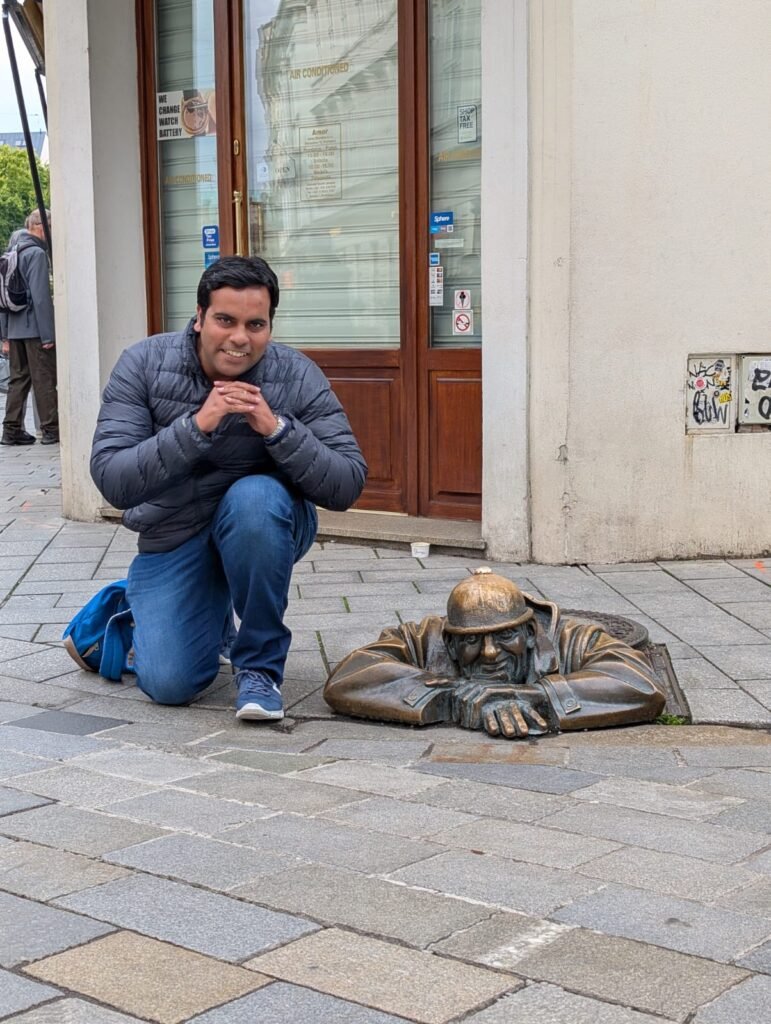
Schöne Náci – The Schöne Náci statue pays tribute to Ignác Lamár, a real-life Bratislava eccentric who strolled the streets in a top hat and tails, politely greeting ladies with “I kiss your hand” in three languages (Slovak, German, and Hungarian). Inspired by his clown grandfather, he became a beloved local figure, charming the city with his elegance despite living in poverty.
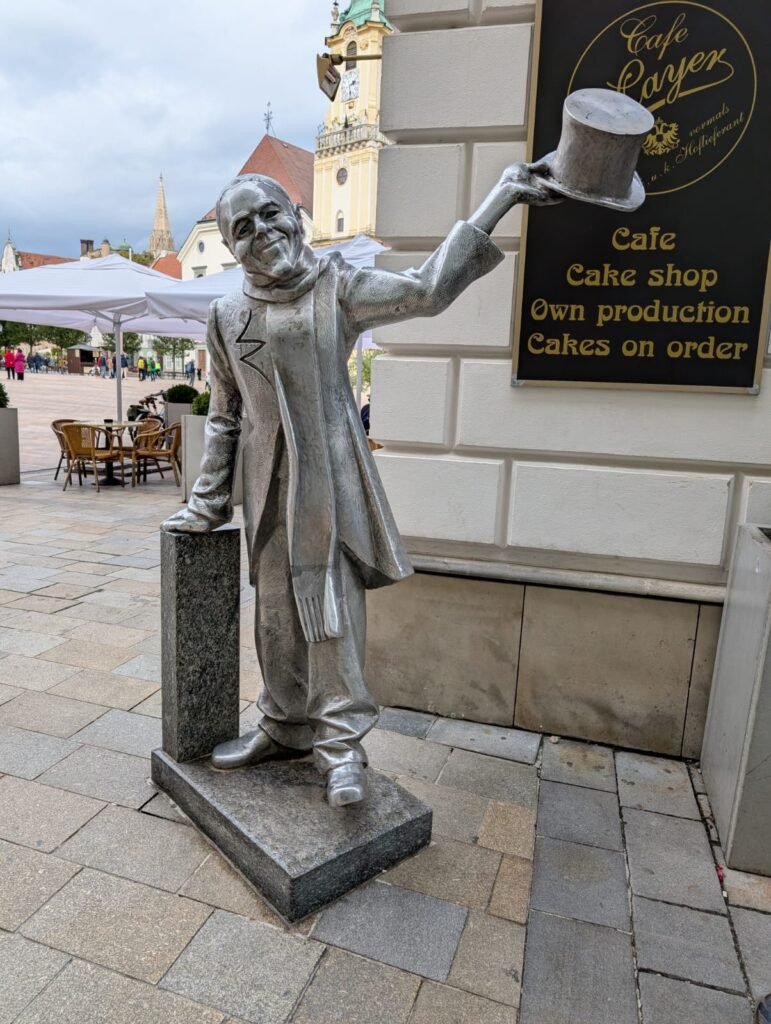
💡 Tip: There’s a free press photographer who captures your photo and prints like an old newspaper. It’s the perfect souvenir. For privacy purposes, they have a disclaimer that they keep no photos. We thought it was a love gesture!
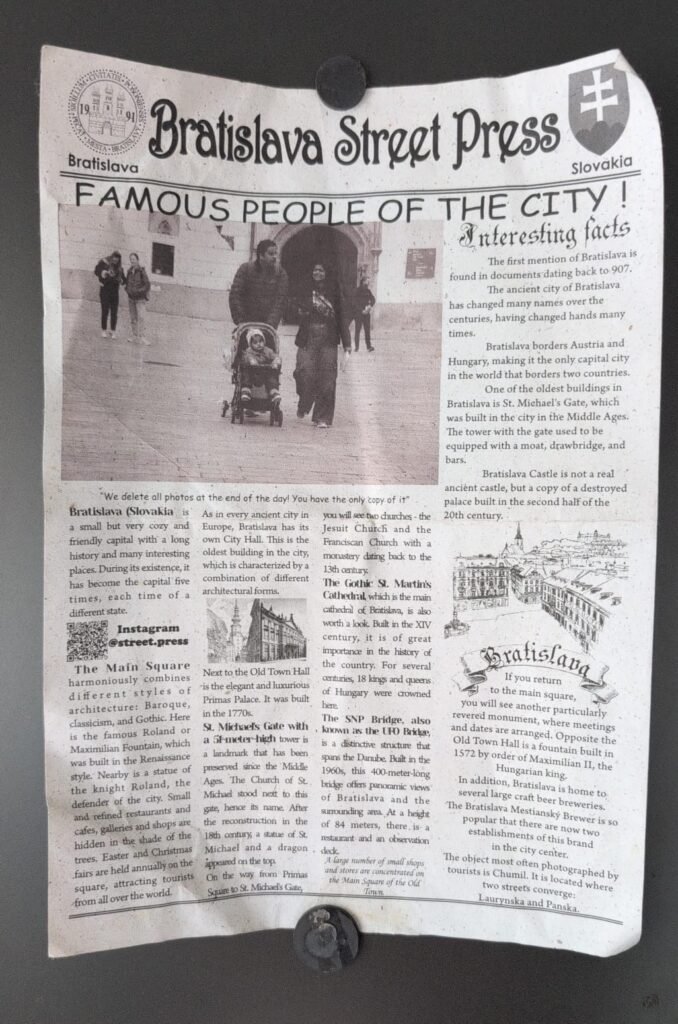
4. Indulge in a Hearty Slovak Lunch
Time to refuel! For an authentic Slovak meal, head to Bratislava Flagship Restaurant. Before it became a lively beer hall serving up Slovakia’s best comfort food, this grand building was once a monastery! The 18th-century structure originally housed the Convent of the Merciful Brothers, a religious order known for their charitable work and hospital services. Over the centuries, the building transformed from a monastery to a cinema and then finally into one of the largest restaurants in Central Europe.

Despite its many changes, the restaurant still retains its historical charm, with high vaulted ceilings, long wooden tables, and a grand hall reminiscent of its monastery days.

💡 Fun Fact: If you look closely at the architecture, you can still spot remnants of the monastery’s past, making this a place where history and hearty Slovak food go hand in hand! 🍻
The menu features hearty local dishes like:
- Bryndzové halušky – Potato dumplings smothered in sheep cheese and topped with crispy bacon.
- Garlic Onion Soup in a Bread Bowl – A warm, comforting hug in food form.
- Slovak Meat Platter – Juicy and spiced to perfection.
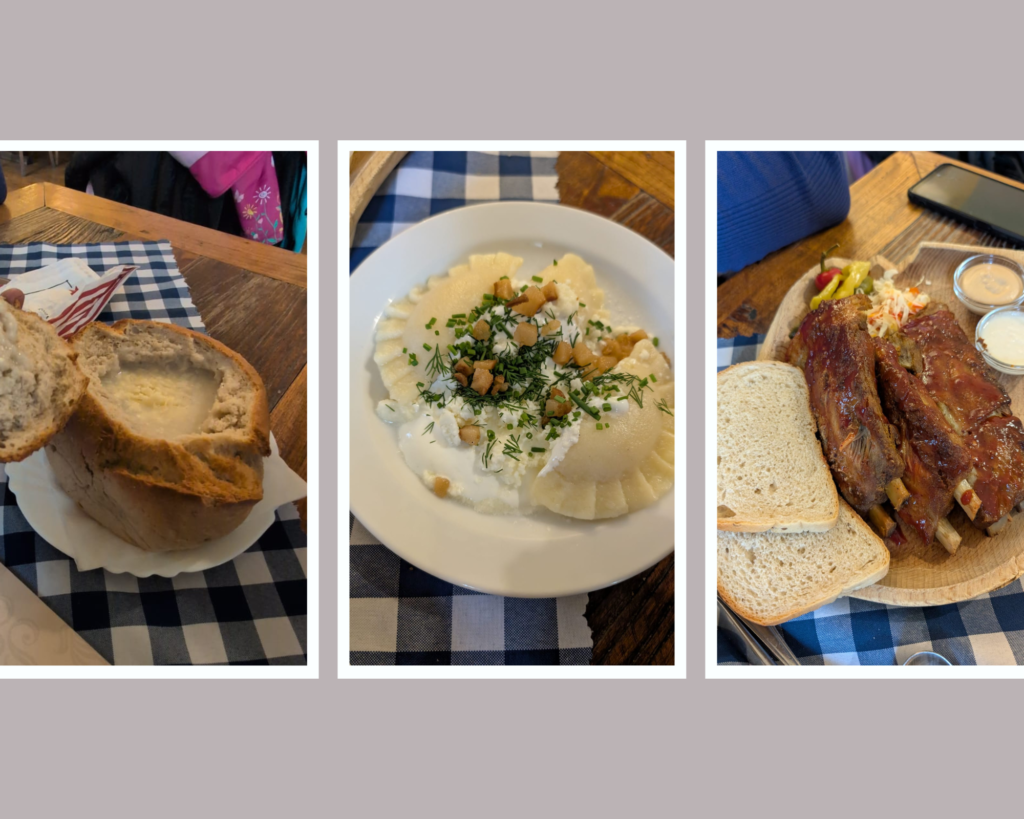
💡 Tip: Order a glass of Kofola, Slovakia’s version of Coca-Cola, slightly herbal and not as sweet—it’s a nostalgic favorite among locals!
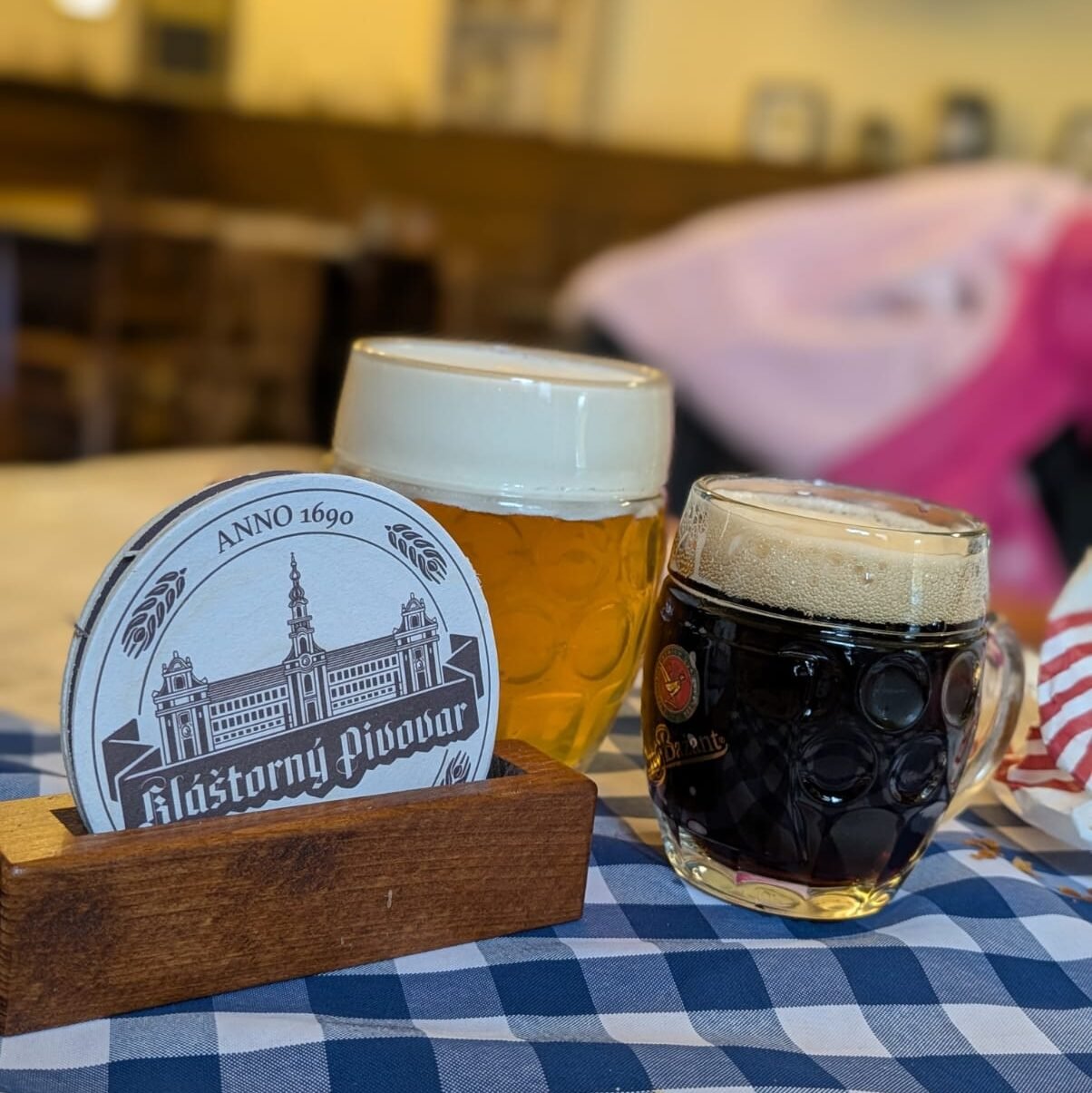
5. Step into a Blue Fairytale
After lunch, make your way to St. Elizabeth’s Church, better known as the Blue Church. Built in 1908-1913 in the Art Nouveau style, its pastel-blue façade, blue-tiled roof, and even blue interior make it look like a whimsical wedding cake. The architect, Ödön Lechner, is often called the “Hungarian Gaudí” because of his love for colorful, organic designs.
Originally a chapel for a nearby school, the church was dedicated to St. Elizabeth of Hungary, who was born in Bratislava. Inside, you’ll find intricate mosaics, a dreamy blue-and-white altar, and stained-glass windows that flood the space with soft, ethereal light.
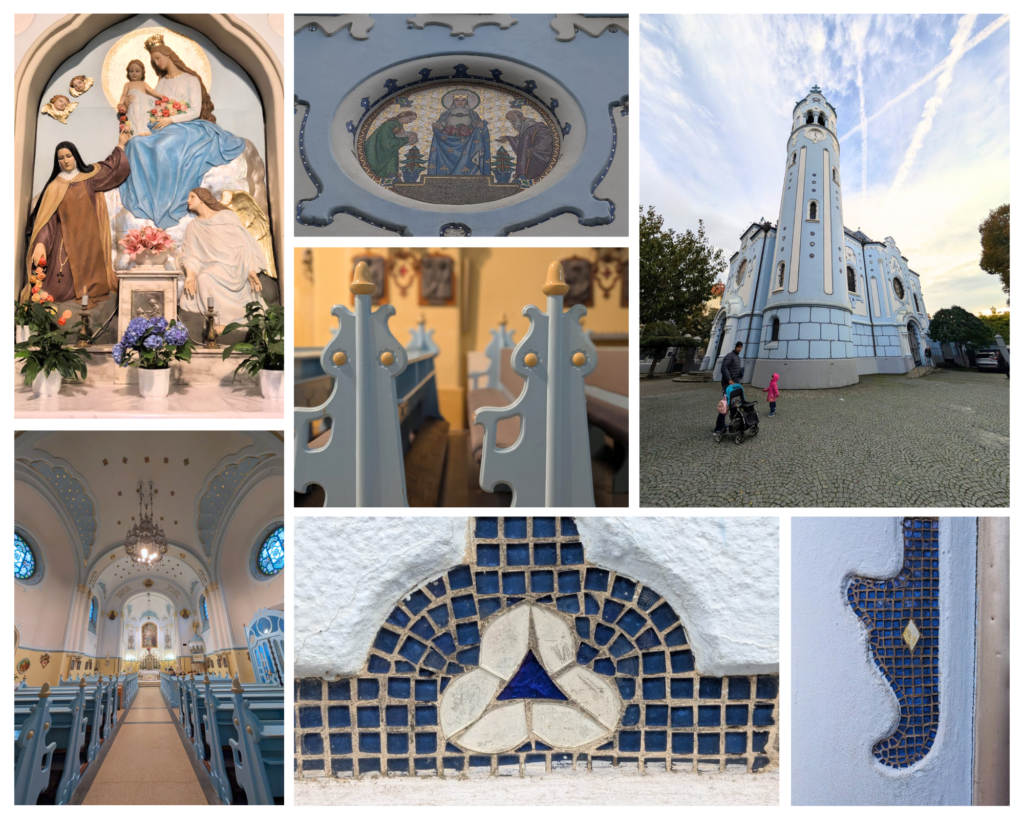
With its dreamy pastel-blue façade and Art Nouveau curves, it’s one of the most photogenic spots in the city. Inside, intricate stained-glass windows cast colorful reflections on the walls, adding to its storybook charm. Many locals believe the Blue Church is a symbol of good luck, and it’s a popular choice for weddings—imagine saying “I do” in a real-life fairy-tale setting!

6. A Bridge with a View
For stunning views of the Danube, walk across Starý Most. Despite its name, Starý Most (meaning “Old Bridge”) is actually Bratislava’s newest bridge! Originally built in 1890, the bridge has been rebuilt multiple times due to war damage and structural issues, with its most recent reconstruction completed in 2015. Spanning the Danube River, it connects the historic Old Town with the modern Petržalka district.

Unlike other bridges in the city, Starý Most is car-free, making it a favorite for pedestrians and cyclists. With dedicated tram lines, wide walking paths, and panoramic views of the Danube. From here, you can admire Bratislava’s skyline, with the UFO Tower standing tall in the distance. One of Bratislava’s most futuristic landmarks, the UFO Tower sits atop the SNP Bridge (Most SNP), seemingly floating like a flying saucer above the Danube River. Built in 1972 during the Communist era, it was a bold architectural statement meant to symbolize progress and modernity. Standing 95 meters tall, it offers the best panoramic views of the city, stretching all the way to Austria on a clear day!
Inside the UFO, you’ll find a 360° observation deck and a high-end restaurant serving Slovak and international cuisine with a side of breathtaking scenery. The elevator ride up takes just 45 seconds, and for the adventurous, there’s even a skywalk experience where you can walk along the tower’s edge!
💡 Fun Fact: The UFO Tower is one of the few “space-age” structures in Europe, and its unique design has landed it a spot among the World Federation of Great Towers, alongside icons like the Eiffel Tower and the Empire State Building! 🚀
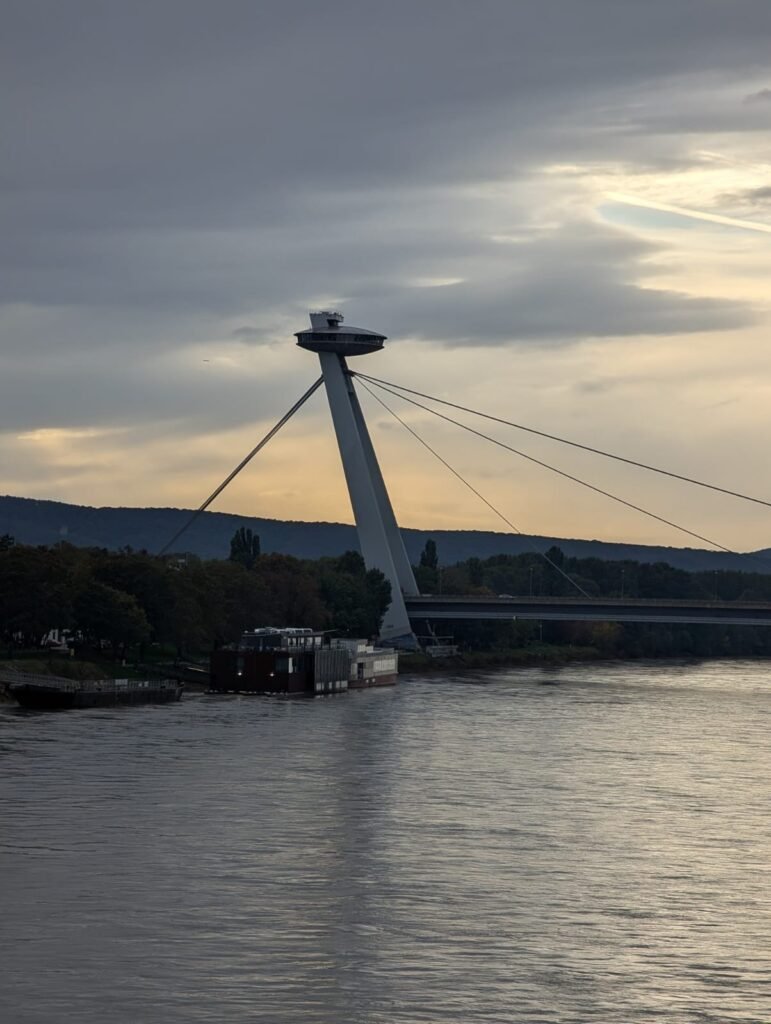
7. Final Evening Stroll & Farewell to Bratislava
Before leaving, wander back through Main Square to spot some more of the beautiful architecture and local historical pieces.
Maximilian Fountain – Located in the heart of Main Square (Hlavné námestie), the Maximilian Fountain is Bratislava’s oldest fountain, built in 1572 by order of King Maximilian II of Habsburg. Also known as the Roland Fountain, it features a statue of a knight in armor, believed to represent either Maximilian himself or the legendary knight Roland, a protector of medieval cities.
Legend has it that on New Year’s Eve, at the stroke of midnight, the statue magically bows towards Bratislava’s Old Town Hall—but only those with pure hearts can see it! Over the centuries, the fountain has remained a central gathering spot, where locals and travelers alike pause to admire its history and beauty.

Nepolean’s Army Soldier Statue – The moment you enter the Main Square, you’ll spot a bench where you can pose alongside the Napoleon’s Army Soldier Statue. Leaning casually on a bench in Bratislava’s Main Square, this playful bronze statue depicts a Napoleonic soldier, a nod to when Napoleon’s army briefly occupied the city in 1805. According to legend, one of Napoleon’s soldiers fell in love with a local woman, decided to stay behind, and started making sparkling wine, which later became Slovakia’s famous Hubert brand!

Michael’s Gate – Pass by the Michael’s Gate, standing tall since the 14th century. It is the only surviving medieval gate of Bratislava’s original city fortifications. Originally part of the city’s defensive walls, it now houses a museum of medieval weapons and offers a panoramic viewpoint from the top, where visitors can enjoy stunning views of the Old Town.
Beneath the gate lies the “Zero Kilometer” plaque, which marks distances from Bratislava to major world capitals. Legend has it that if you walk under the gate at midnight, you’ll be granted eternal wisdom—or at least a great story to tell!
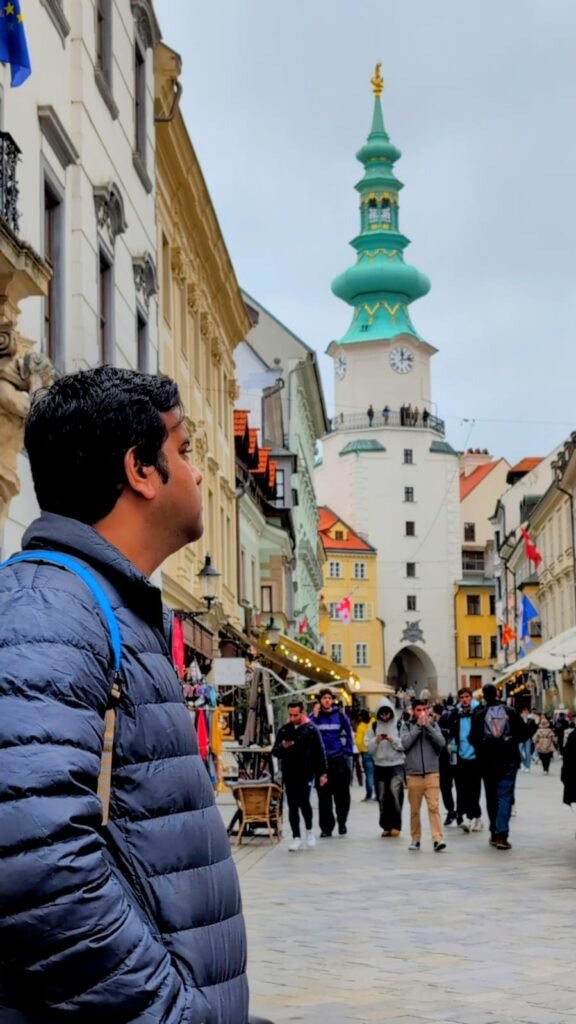
Miniature Bratislava – As you walk towards the end of your tour, take a moment to visit the detailed miniature model of Bratislava’s Old Town, cast entirely in bronze, offers a bird’s-eye view of the city’s historic layout. Located near the Slovak National Gallery, it showcases key landmarks like Bratislava Castle, St. Martin’s Cathedral, and the Old Town Hall, helping visitors visualize how the city looked in centuries past.
Designed to be touch-friendly, the model is a great interactive feature, especially for visually impaired visitors. It’s also a perfect photo stop, especially at sunset when the nearby UFO Tower and SNP Bridge create a stunning backdrop.
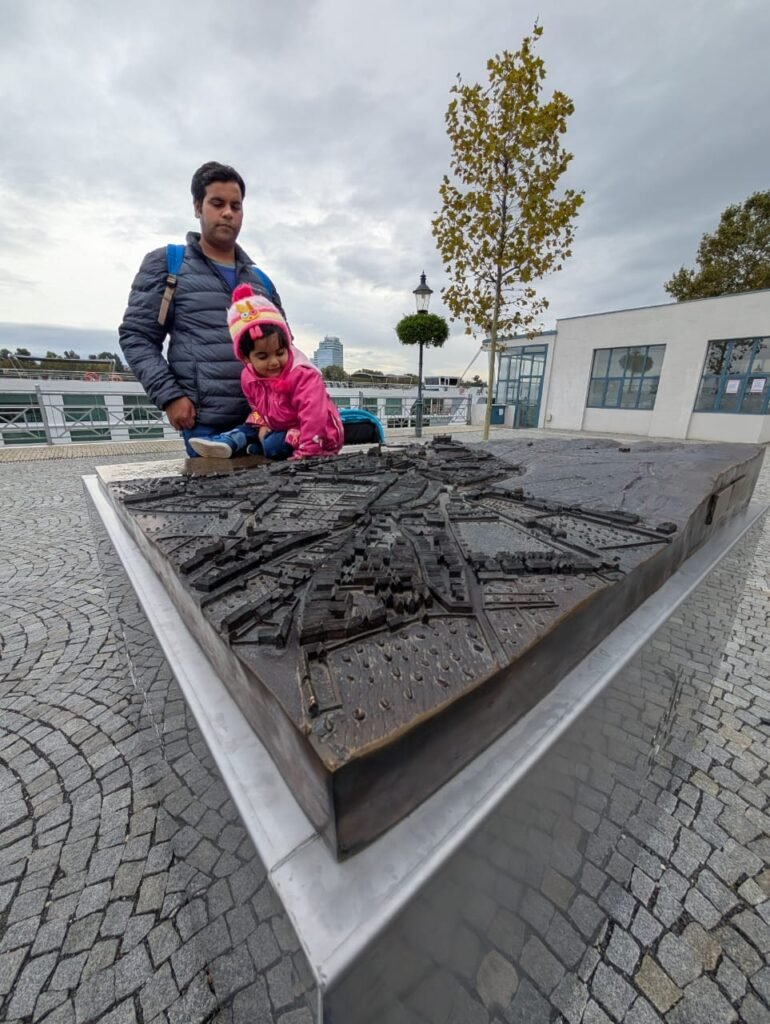
As the sun sets, the city takes on a golden glow, making for a perfect farewell to this charming capital. Take some time for souvenir shopping, smiling at locals, playing at the free parks, or simply processing the fact that the world is so beautiful!
Budget Breakdown: Lux, Comfort, and Budget Options
| Expense | Luxury | Comfort | Budget |
| Train (Vienna-Bratislava) | €25 | €10 | €5 (advance ticket) |
| Transport | €20 | €10 | €5 (public transport) |
| Food | €50 | €30 | €15 |
| Sightseeing | €15 | €10 | Free (if skipping paid museums) |
| Total per person | €110 | €60 | €30 |
Final Thoughts
Bratislava may not be the largest or most famous European capital, but it has a distinct charm that makes it unforgettable. Whether you’re drawn in by its medieval history, its whimsical statues, or its comfort food, this city is perfect for a day trip that lingers in your memory.
If you are starting to plan about your next Europe trip, hop on to our blog to travel through Central Europe in 14 Days, with expert-crafted itineraries, insider recommendations, and secret travel hacks ready to go!
Happy Travels!


